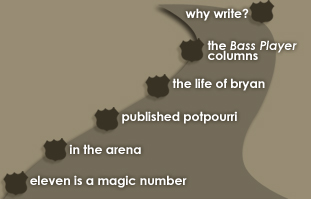
 |
|||||||||
|
|
|||||||||
| Sign up for BellerBytes, the official (and private) Bryan Beller e-newsletter. Just click here to sign up. Do it, OK? | |||||||||
|
Column
#3: Getting In Over Your Head If they’re going to call this column Learning Curve, I’d better get around to the learning process sooner or later, right? Maybe you’re not like me. Maybe you drilled yourself silly with a metronome until you could play a three-octave Eb half-diminished scale in 16th-notes at 150 beats per minute on your 7-string. But for me, the key was learning songs. After all, why did you start playing bass in the first place? Was it because you wanted to play along with John Bonham, or because you felt the need to master a fingering exercise? I’m not saying scales and technique aren’t important; without the proper tools, a carpenter will only scratch his head when asked to build a house. But with all due apologies to Jeff Berlin, I’ve had some of my most significant playing breakthroughs when learning a tune that was slightly over my head for one reason or another. I’m sure I’m not the only bassist who heard a song with a killer bass line and thought, Man--if only I could do that I’d be so much happier. Then a funny thing happens: While learning the song, you discover a technical or mental aspect to playing you never would have considered otherwise. These magical tunes are different for everyone, as different strokes make for different blokes. Here are the four songs that hit me the hardest. Led Zeppelin, “In My Time of Dying” [Physical Graffiti, Atlantic]. One of Zep’s overlooked epics, “Dying” clocks in at over ten minutes and contains three sections. The first is a drawling, stop-and-start groove centered around Jimmy Page’s slide-guitar motif, with John Paul Jones harmonizing the main lick a third above. But just when you think the song is merely plodding along, it cracks into one of the funkiest uptempo bits never to frequent AOR radio. For four solid minutes Jones and Bonham back Page’s slide solos, with JPJ pumping out 16ths fat and fierce. Finally, after a furious lick ends the solo section, the main riff comes back in a completely unexpected way. Listen to how Jones remains steady while Bonham plays fill after deadly fill, each meaning more than the previous. By the time Robert Plant is ready to meet St. Peter, it’s easy to forget Bonham and Jones are the ones who got him there. Learn this gem from back to front, and in the process glean the secret to Zep’s rhythm-section magic: Bonham swings everything. JPJ was clever enough to lend his lines a dash of bounce for compatibility’s sake, and voilà!--rock groove was redefined. Get Jones’s bounce under your fingers and you’ll have a new weapon in your arsenal. Jaco Pastorius, “Reza/Giant Steps” [Invitation, Warner Bros.]. The climactic Invitation tune features Jaco stretching out over Peter Erskine’s 12/8-inside-4/4 Latin-inflected groove while trumpeter John Faddis solos for nearly five minutes. Jaco slides effortlessly between the A minor tonal center and myriad other possibilities, sometimes a half-step away, occasionally hitting the major 3rd, even footballing the tritone--and always emoting the underlying menace of the building solo. When the big-band horns step in, he lays back and grooves in the key as only he can. Then the tune explodes into a hyper-paced Caribbean take on “Giant Steps”--but instead of walking like a maniac, Jaco chooses to play only repeated half-notes, leaving plenty of space for the steel-drum solo. He simply takes over the track for the final two minutes, playing with the overdrive on full as the main theme returns. If you can’t feel the desperate emotion in his 32nd-note burst near the tune’s end, you haven’t been listening closely enough. The passion he put into this performance is worth more than any amount of chordal harmonics or perfectly executed 16th-notes. It’s easy to miss the point with Jaco because he was so technically sound, but this song will not let you. It was him being himself at his peak. Are you able to tap that same emotion in yourself? The
Raging Honkies, “I’ll Get Away” [We Are the Best
Band, Smashed Hits]. What? Who? Perhaps you’ve heard of Michael
Landau, L.A. session guitarist extraordinaire. He and his brother, bassist
Ted, were two-thirds of this now-defunct power trio, along with Abe
Laboriel Jr. on drums--a Bonham for the ’90s. “I’ll Get
Away” is basically one slow, greasy lick over and over again--but
the hidden treasure is the bass track. At every turn, while Michael
burns the musical landscape to the ground, Ted just pumps out the line
over and over again--never playing a fill, not wavering even once. It’s
masterful discipline you can appreciate only by hearing the track; Ted’s
stubbornness in the face of this madness is a lesson in itself. By the
way, this is the perfect song for first-time pick players. You’ll notice the lack of written musical examples to go along with the above tunes. Your mission, should you choose to accept it, is to create your own. And if these tunes don’t do it for you, fine. Find your own and tackle them with abandon. Just make sure that, for one reason or another, they’re slightly out of your reach. Or you can click on the metronome and hit that two-octave C# Locrian mode one more time. Your choice. By Bryan Beller, copyright 1999 United Entertainment Media. Reprinted from the December, 1999 issue of BASS PLAYER. Reprinted with permission from BASS PLAYER. For subscription information, please call (850) 682-7644 or visit www.bassplayer.com |

|